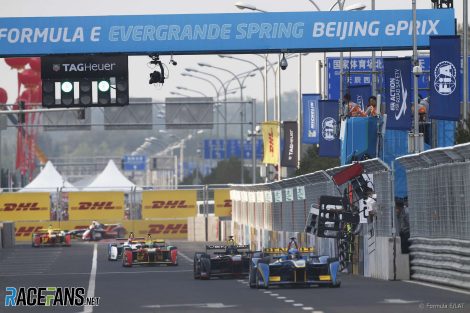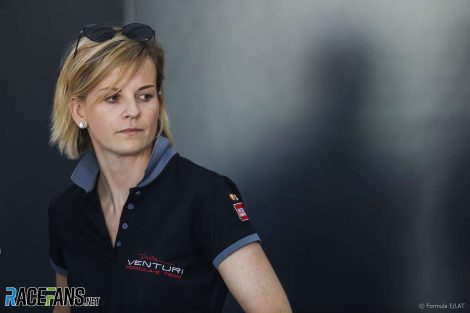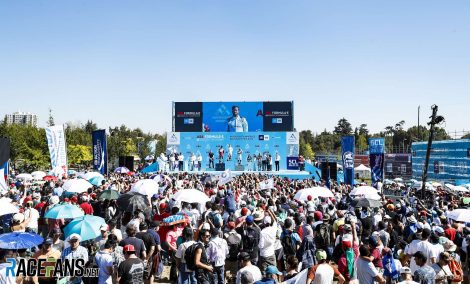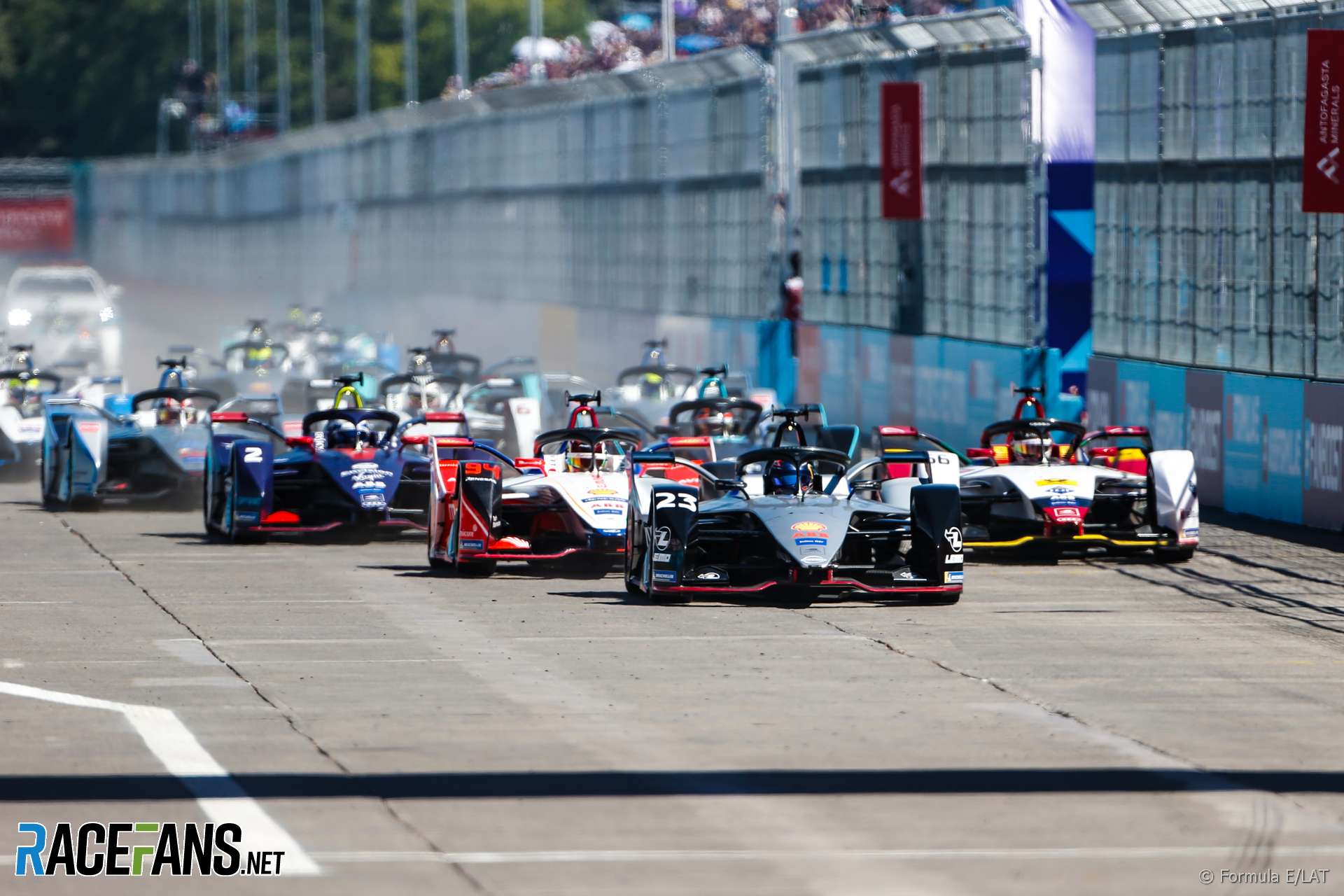In the space of five years Formula E has attracted a swathe of manufacturers and swelled its grid. But motorsport’s greenest championship isn’t in the black yet.
How long will Formula E take to turn a profit? When will its manufacturer and independent teams start to see a share of the sport’s income – and will they remain committed in the meantime? @DieterRencken spoke to the key players.
Twenty years ago the number of start-up international single-seater series was negligible. Aspiring F1 drivers broadly adhered to a ladder which climbed through Formula Ford (or Renault) to Formula Three to Formula 3000 – the confusingly-named successor to Formula Two. True, there were interlopers such as Super Vee or FF2000, Formula Atlantic and Formula 5000, but in the main these were national series, with professionals following the formal ladder, certainly for cross-border racing.That changed with the formalisation of the European Union – which resulted in the tearing down of borders between its countries – and a 2000 ruling which affirmed the FIA as motorsport’s administrator/regulator, not its promoter. This obliged governing body to recognise all forms of motorsport, whether in competition with each other or not, provided they comply with prescribed safety standards and adhere to administrative procedures.
Concurrently the EU ordered that Bernie Ecclestone, who had been awarded the rights to all the FIA’s championships under a deal brokered by his friend of 30 years, then-FIA president Max Mosley, should relinquish the rights to all bar a single championship to prevent motorsport from becoming a monopoly controlled by a single individual.
That done, the result was a proliferation of start-ups. These included Formula Palmer Audi, myriad one-make championships punted by brands such as BMW, Renault and Abarth, plus the likes of GP3, A1 Grand Prix, Auto GP, Superleague Formula, Formula Renault 3.5 (in various guises) – all in addition to F3 and F3000. The latter was later mysteriously acquired by Formula One Management and rebranded as GP2, while Euro 3000 sprang up to give a home to the old chassis.
History relates that most of these series have disappeared, with A1GP’s implosion being the most spectacular. Still, the bare bones of that series remain, for the latest is that the cars – based on 2004 Ferrari F1 chassis fitted with modified 2008 Ferrari road car V8s – are to form the basis of a pan-African championship. Whether that sees the light of day remains to be seen.

Since 2014 Formula E has zipped from zero to a level that sees it regularly (but wholly unfairly) likened to F1 – a comparison it is trying to avoid. That does not imply Formula E is inferior, just as tennis / squash comparisons are inappropriate: both are racquet-and-ball games, but their rules of engagement are vastly different. Of course, fans may watch (or play) both, but there is no doubt about which sport tops its genre in every respect.
However, each gain inevitably brings an element of pain, and now that Formula E’s future seems bright there are the expected rumbles about the two crucial elements that eventually blight any successful motorsport championship. These are costs and income – which fall neatly under the combined heading of ‘money’.
As Formula E CEO/chairman Alejandro Agag outlined when he spoke to RaceFans recently, the formula’s costs are kept largely under control by regulations that oblige manufacturer teams to supply independents at prescribed costs. “If you’re going a spend a lot of money, 100 million, 200 million on a powertrain that then you have to sell for €400,000 to another team, you think twice.”
Which leaves the question of income, more succinctly the question of Formula E sharing a slice of its revenues with the teams. A glance at its income statements vividly illustrates its rapid growth: for the year ending July 2017 the series generated £105m, well up on £81m for the previous year. Its 2018 financials are due to be filed by the end of May, but during our interview with Agag he pointed to expectations of around £185m.
Advert | Become a RaceFans supporter and
Intriguingly, this figure is around 10 percent of F1’s turnover, a proportion which applies to several other key metrics: Where F1 team budgets average around $200m annually, Formula E teams spend around $20m; live and television audiences are also roughly in line with the 10 percent factor. Thus, in many ways, Formula E is as cost-effective for teams and sponsors as F1, with the advantage of a different, younger demographic.
However, despite these impressive numbers, in its previous financial year Formula E recorded losses of £18m (down from £32m in 2016) and accrued liabilities of £115m (up from £90m), so the numbers have encouraging trajectories. It is, though, on the basis of these recorded losses that Formula E won’t (can’t) pay teams for their participation, which costs anything between £15m and £30m, funded purely by a combination of parent companies or sponsors.

“We will share our revenue with the teams, but we are not there yet.”
The Formula E model is essentially that of a process company: It buys in goods and services from suppliers (teams), processes and packages the product (races), which it sells to wholesalers (promoters/broadcasters), who retail it to customers (TV/live audiences). Now imagine a start-up factory not paying suppliers simply because it is not (yet) in the black.
Agag’s responds when I put this to him was: “[My] initial equation is wrong. I am the supplier for the teams, not the teams for me. I supply teams with a platform. They pay to be part of my platform. I give them from the charging infrastructure to the tracks in the cities to the broadcasting so that people can see them, to a brand, a strategy with marketing, and so on. We give them services; like that they should pay us…”
All well and good, and for now Formula E has the strength in numbers (of participating teams) on its side. But how much longer before teams start agitating for their shares? Particularly as three-quarters of the grid is owned by car makers at a time when the overall industry faces torrid times. When Formula 1 was hit by similar storms in 2008/9, manufacturers pushed for increased revenue shares, yet five many departed.
James Barclay, team director of Jaguar Racing, believes a revenue share model is inevitable once “Formula E has matured though its first phase,” adding that “it’s now absolutely proven itself about being a very, very exciting branch of the sport.
“At the moment it’s a model which fundamentally [has] the promoter still recouping the costs of investments. From our perspective, we are fundamentally coming and paying to race in the championship, and our revenues, we can pull in additional forms through outside sponsorship, but not through the promoter.

Ulrich Fritz, team boss of newcomer HWA, effectively a Mercedes proxy team, largely shares Barclay’s views about revenue sharing. He, though, adds that “The truth is in between [sharing or not], and it needs to be an [sustainable] ecosystem in the end. At the moment the ecosystem runs like it is, and everybody is fine with it, otherwise they would leave.”
Fritz, who saw manufacturers come and go during his previous tenure as a DTM team boss, acknowledges that risk. “That’s what we have to take care for the future,” he says.
Indeed, Audi Motorsport Director Dieter Gass, who joined the Four Rings from a senior management position with a manufacturer F1 team that exited in 2009 (Toyota), believes that manufacturers will inevitably leave Formula E at some stage.
“We have seen I think quite a few championships where you have many manufacturers involved, and we have seen with all these championships that this was not lasting a length of time,” he says.
“We never had a period of seven, eight years with so many factories involved, so I think we’re going to see the same situation in Formula E. You have everybody in, and there will be a point where people start losing interest, for whatever reason. Whether their ROI is not good enough, whether their performance is not good enough or whatever.
“So I don’t think we can assume that from now on for the next five or 10 years we’re going to be running with the same amount of manufacturers. It will reduce.”
Go ad-free for just £1 per month
>> Find out more and sign up
As in F1, manufacturer involvement brings with it ‘freebie’ marketing and activation activities, so it is absolutely vital that Formula E maintains a strong and vibrant manufacturer contingent. Here the series can learn from F1: once the manufacturers left F1, the sport suffered a massive marketing void that Liberty has yet to plug completely. And, for start-ups, marketing is crucial.

Wolff believes it will take time for Formula E to become profit-making. “One aspect is that Formula E is a young start-up,” she explains. “It’s a completely new way of going racing; it’s a very different audience to that of, let’s say, a normal motorsport championship.
“That is why it’s attracted the interest of so many manufacturers, because it’s in line with the way the automotive industry is developing. And for this concept, function of one-day events in city centres with huge costs of build-up, it’s clear that it’s not profit-making yet. Because in the end Saudi was the first really big deal where you could say, ‘OK, that’s shows what the value of Formula E is.’
“[Formula E] has some fantastic shareholders, but in truth it’s a loss-making entity. And it’s far away from being a profit-making entity right now. I mean, things can change very quickly in this business, but right now it’s far away from being profit-making. So for me the key aspect which they need to be very, very diligent on is what it costs us to go racing.”
That, in a nutshell is the key: Formula E’s cost-to-income equation. As long as costs can be contained, clamours for shares of revenues can be warded off; once that changes, whether for manufacturers or independents, Formula E faces two scenarios: depleted grids or diminished coffers; maybe even both.
Those are the major obstacles facing Agag in the near-to-medium-term, and arguably represent a bigger challenge than getting the series off the ground, for start-ups generally benefit from an element of sympathetic indulgence. However Wolff is confident the series is “in very good hands.”

“I think probably if Dieselgate hadn’t happened, this paddock would look very different right now. But Dieselgate did happen, and there was a huge race in manufacturers to showcase electric technology. But I believe that motorsport has always been relevant for manufacturers. There’s a reason why manufacturers choose to go racing, because if gives them a sporting element to their brand, it allows them to showcase their technology, and it allows them to have a huge marketing story.
“I can’t speak for the big manufacturers, but certainly there is a lot of relevance for Formula E, and I do have a lot of faith in the people running the sport.”
While there is no doubt that, as Wolff says, Dieselgate accelerated Formula E’s global acceptance, the fact remains it currently boasts full grids through its own merits, one of which is an extremely robust promoter-competitor relationship that will serve it well as the series consolidates phase two of its growth plan. Formula E looks likely to remain motorsport’s most successful start-up well into the future.
Advert | Become a RaceFans supporter and
RacingLines
- The year of sprints, ‘the show’ – and rising stock: A political review of the 2021 F1 season
- The problems of perception the FIA must address after the Abu Dhabi row
- Why the budget cap could be F1’s next battleground between Mercedes and Red Bull
- Todt defied expectations as president – now he plans to “disappear” from FIA
- Sir Frank Williams: A personal appreciation of a true racer





Steven Robertson (@emu55)
30th January 2019, 13:05
I think Formula E is in a unique position where it is not a lower formula support series like the ones mentioned but the potential replacement for Motorsports top dog, Formula 1. This unique aspect could ensure its survival purely as a business investment, Liberty could purchase Formula E and merge the series to make some people a lot of money.
IJW (@)
30th January 2019, 13:49
@emu55 Already done (in a manner of speaking). Liberty Global (has an interet in FE) is owned by the same man who owns Liberty Media (which has an interest in F1).
RogerAyles
30th January 2019, 13:20
i’ve given formula e a chance and i don’t think i shall be watching anymore as i just do not find it to provide the sort of actual racing i want to and enjoy seeing.
formula e always feels like a lottery rather than an actual race because there is too much chaos be it penalties, contact, fanboost or this silly video game action zone. there may be a bit of action going on but it all feels chaotic and artificial rather than an actual race & i just do not enjoy this.
it reminds me a lot of a nascar restrictor plate race. there all side by side in a big pack with 80 something lead changes & hundreds of other position swaps through the field but it doesn’t feel like your watching a race. and with the chaos caused by the big wrecks your often left with a feeling that those who made it to the end did so based on the luck of the lottery those races are rather than because they drove better than the rest.
it feels too much like mario kart & while i do enjoy playing mario kart i don’t want to watch something like that for real.
Don
30th January 2019, 17:55
Agree with your summary.
Sorry to the FE fans, but for me the racing is quite boring as the cars look really slow and the sound of a dentist drill at times is like fingernails on a chalkboard to me. About the only thing of interest is when there is a crash, which means the racing is crap (to me).
How they’ll make any money also in the future is a mystery to me. Even though there are numerous Mfg’s that want to be involved with slot track racing, turning it into a money maker (like any racing) will be tough.
az
30th January 2019, 18:28
+1
It’s seems the word “Formula” in FE is just there to engage/deceive fans and former F1 drivers, because both F1 and FE are completely different things (for now). I think FE is more close to stock car racing because of the speed, the circuits and the racing style (bump-to-overtake). Regarding aerodynamics, I wonder how much performance gain FE has, considering the (urban) circuits layouts and the speed.
JC
31st January 2019, 0:52
It’s a spec series, thus a formula series.
There’s a big list of what a car has to be. For FE it’s a large set of standard parts with some freedoms and the ability to buy components from competitors. For F1 it’s a complex rulebook around dimensions, angles, etc plus a standard ECU and some rules on buying components from competitors.
tony mansell
30th January 2019, 13:53
Any big business is in bed with corruption and lies. Car manufacturers are no exception. A grubbier bunch you will find it hard to find. As soon as electricgate hits or politicians decide electric isn’t the way forward (and it isn’t) I doubt it will survive. The racing has got better, the tracks are pony but necessitated as watching theses sub Formula Ford speeds would look awful on a proper track.
Big Joe
30th January 2019, 15:45
How many ‘proper’ tracks are there in city centres?
How many ‘proper tracks’ are actually sell-outs anyway? 1 or 2 F1 races per year, including Monaco ironically! (I recall seeing empty seats at every F1 race in recent years) . Most other series are struggling to get bums on seats. Many racing in empty stadiums.
Thankfully there doesn’t seem to be much criticism from the young fans this series is aimed at. A lot of women and children at the actual races and participation in the ever important social media sphere.
I agree the manufacturers are corrupt.
Electric cars might not be the future, but who said cars are? electric buses, bikes, scooters probably will be.
There has to be a post-car future. And there will likely be a post-racing car future.
LyndaMarks
30th January 2019, 16:10
i see a lot, both my teenage sons watched it & gave up for the same reasons many older fans did.
i also see that the young fans the series are aimed at are not watching it which is why the series is constantly bouncing around tv channels as it’s dropped due to low ratings which in the uk at least have declined every year.
even now when it’s on about 4 tv channels and youtube the uk viewing figures have been abysmal.
anon
30th January 2019, 18:48
LyndaMarks, I’m curious on what you are basing the assertion that the figures have declined every year in the UK, as the figures seem to show the average viewing figures tending to go through cycles of rising and falling between seasons.
GT Racer (@gt-racer)
31st January 2019, 1:40
Saying they have declined every year would indeed be inaccurate. However the ratings right now are significantly lower than they were at the start of season 1.
I also believe the trend each season has been figures starting out OK but dropping off as the season went on which is what caused ITV & Channel 5 to lose interest after initially strong backing. The Formula E coverage on Channel 5 was regularly below the averages from the time slot it was in which is one of the things commercial broadcasters look at as they need to hit the expected average number of viewers in each slot in order to meet commercial agreements & attract new brands for there ad-time.
Alianora La Canta (@alianora-la-canta)
1st February 2019, 7:40
Somehow this does not surprise me. Formula E has never helped itself by having the races 1-2 weeks apart (with the occasional 3-week gap where strictly necessary); there have always been weird long gaps in the schedule. This year, despite more compression than usual, remains a good example; starting in early December, then a month-long break (preventing it from building on the strength of any particular start), then fitting in another 11 rounds into 7 months, still having 3-week gaps all over the place. Even F1 tends to lose viewers in the summer holiday, and that’s with the most social media promotion of any motorsport series. Doing so with a low user base pretty much limits the audience to those who are comfortable with complete dependence on catch-up services – a growing part of the population, but still a minority. It also means that as the season gains definition, people are more likely to drop out in the 3-week breaks. A more concise and regular schedule, to respect the fact the series only has 12 venues instead of 16+, would help Formula E a lot.
Formula E is also really bad at mid-series promotion. It seems to rely on broadcasters and on-site promoters doing “outreach” (since Fanboost has proven only to preach to the converted, due to its being well-established). This barely works for F1, and that’s with people paying through the nose to get the rights and therefore taking their efforts to claw back the income more seriously than the relatively low levels FE can command as a start-up.
Further, Channel 5, even in the beginning, had a disconcerting tendency to shift races to different channels or make them non-live for such things as children’s TV. It never really got a chance there.
I’d also add that on the BBC’s Red Button platform, it took my family nearly an hour to get the Formula E initial round to run. If this is in any way typical for people who don’t routinely use the current version of the BBC Red Button, that will put off a large number of people, even those comfortable with catch-up.
petebaldwin (@)
30th January 2019, 16:47
Why though? Horse racing is big business and we moved past that as our main form of transport a long time ago.
I think the problem is that cars in general aren’t exciting these days – they’re conservative and efficient rather than loud and aggressive. As F1 handed most of its power to the manufacturers and it benefits them to develop road relevant stuff, F1 has gone the same way.
If a top-spec open-wheel series started up with proper engines on proper tracks with simple rules, it would eventually overtake both F1 and FE.
Don
30th January 2019, 21:52
IndyCar.
anon
30th January 2019, 22:31
@petebaldwin, this does feel like a conversation that is going to go into the inevitable and rather predictable cycle of people chiming in that things were always better in a reference frame that is 20 to 30 years further back in time.
Jay Menon (@jaymenon10)
31st January 2019, 2:47
“Electric cars might not be the future, but who said cars are?”
Very good comment. I’ve been bringing this more often in conversations with friends. I believe in the future, probably the latter part of this century, cars will become irrelevant, especially in cities. Cities will become car free. Many cities already have traffic free zones.
Young people these days don’t want to own a car, because you dont need to. Most people only end buying an SUV type thing when they start a family.
kris
31st January 2019, 19:53
I differ, I think they should be on actual race tracks so we can relate, especially those of us that play racing sims. Remember not all tracks are F1 Spec, there is often a national or smaller layout too, and that would be what the FE guys should be doing. Track infrastructure and security is already in place, spectators can see more of the track rather than just one corner or straight and they will be wider with more run off allowing for more actual racing.
But they do need more KW. 200 is not enough, heck my car has 184kw and the sound it makes is amazing, then you have a dremmel whining in FE, diminishes the attraction straight away.
Alianora La Canta (@alianora-la-canta)
1st February 2019, 7:41
There’s no reason a race sim couldn’t include city venues. A missed promotion opportunity, methinks.
petebaldwin (@)
30th January 2019, 16:41
I’m really disappointed by FE. I was desperate to love it and even accepted Fan Boost (not easy) but the bizarre penalties have killed it for me. It’s like they looked at what F1 was doing and thought “let’s make it worse!”
electroball76
30th January 2019, 18:25
Could they add inductive charging under the circuit to give the cars a bit more juice?
JC
31st January 2019, 0:58
That would involve digging up city centre tarmac, so unlikely.
Battery tech has already made a staggering leap in the short time FE has been around. The development needs to be in that area, plus ancillary technology like regenerative braking and efficient power management, all while there’s a focus on lap time and competition.
joe jopling (@jop452)
30th January 2019, 19:41
Its interesting watching how the ex F1 drivers cope in the races….JEV should be still with the big boys in my opinion…..Seemed more of a spectacle when they swapped cars, so maybe a compulsory tyre change could be introduced??….but why, now we do not have Channel 4 coverage, can we only see it free on the BBC red button…..picture quality where I am is not very good….
JC
31st January 2019, 0:55
You can watch all races live on YouTube or the BBC iPlayer app – both in HD, both support casting/smart TV viewing for the big screen.
DB-C90 (@dbradock)
30th January 2019, 21:57
Interesting that FE is still to turn a profit.
Normally, that would mean that their income model is not quite right which leaves them with a choice of increasing the cost of attendance/viewing or increase the cost for the “circuits” to host one.
I understand their reluctance to do either, but at some point, someone’s cost (other than FE’s) has to go up to provide enough income to keep it viable.
At that point, we’ll see if it continues in to the future. Whilst I’m not a huge FE fan, I wish them well.
GT Racer (@gt-racer)
31st January 2019, 1:27
@dbradock
A combination of giving tickets away for free, Reducing prices on tickets at times to the point where they make a loss, There’s very little broadcaster interest so there not making much from TV revenue & are even paying to get on TV in some places.
There not putting races on Youtube for free because they want to. There doing it because in some places they have nowhere else to go & for as wonderful for fans as been free on youtube & other social media platforms is there not making any revenue from it. This is important because TV revenue is where a huge chunk of income comes from.
If there was more interest in terms of broadcasters who were willing to pay decent amounts for the TV rights they would be a lot better off in terms of income.
José Lopes da Silva
30th January 2019, 22:32
I don’t think my personal opinion about F-E as any interest.
Maybe the next generation of motorsport lovers loves more about Mario Kart real races. And we’ll be left complaining like the two old men of the Muppetts Show.
Apparently, under-25s love K-Pop and I barely know what that is.
The best thing about Formula E is that is not tied up to the will of two or three teams. The “FIFA” of F-E can change rules in the future if it wants to. Terminating fanboost, terminating that qualifying issue of sending a few first to clean asphalt, etc. Just like FIFA and UEFA rule football.
Football will be something else as soon as the European clubs decide to cut off with UEFA and run a European Superleague. Which is the same that Ecclestone did around 1980.
Maybe F1 is dead since the teams took over around 1980.
Afro Kiwi
31st January 2019, 21:39
As with fully electric cars, Formula E is sustained not by economics but by ideology and political preference. It cannot make a profit just like electric carmakers can’t really make a profit in an open market.
Both Formula E and electric carmakers therefore need subsidies in perpetuity to break even.
I’m obviously prejudiced, but watching one formula E race live convinced me that this was not the spectator sport for me.
It just felt dead.
Alianora La Canta (@alianora-la-canta)
1st February 2019, 7:49
Several large ICE carmakers have needed huge subsidies for the past decade to break even also. For that matter, all cars get massive subsidies through governments spending tons of money on car infrastructure, on developing towns and cities to the advantage of cars instead of other forms of transport (even pedestrians haven’t really had a look-in again until the last couple of decades, and public transport still gets short-changed when there aren’t “banner projects” in sight). Indeed, the “look-in” pedestrians now get opened a gap where some people now can do without any car at all, and young people have, statistically, voted with not buying a car at all – perhaps carsharing, using a taxi or getting public services for the relatively few times they need other forms of transport. Carmaking in general is not an open market.
Motorsport by and large is an open market, and if Formula E continues to make decisions that work against its becoming popular, it should expect to need subsidies in perpetuity.
Brett Woods (@pertwee)
1st February 2019, 6:42
My thought is that any open wheeled single seater series can be compared to f1 because that series is the benchmark, so comparison is natural. I think a good analogy is not tennis v squash, because in this case, both series are playing the same car racing game. So more like singles tennis v doubles. Slower speeds and slightly different rules. Direct Profit is nice, but having the advertising and development test bed break-even in an R&D/promotion sense will be a good enough achievement for a few years and as you say, revenue is increasing and Fe is proportionally similar to f1. As a going concern I think you point out rightly that Fe is not out of the woods yet as liabilities cannot continue to grow indefinitely. Team revenue sharing also needs to be addressed equitably before it becomes an issue. I enjoy the coverage here and the races themselves.